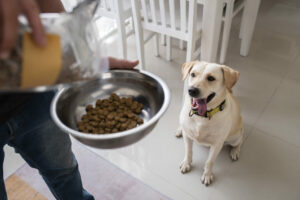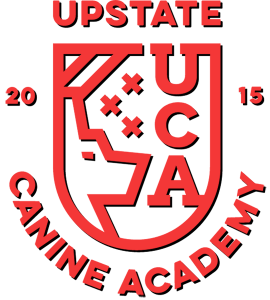Dog food aggression can be a difficult and worrying issue for dog owners. Food aggression, also known as resource guarding, is when a dog becomes hostile or territorial over food. When approached while eating, this can be expressed as growling, snapping, or even biting. Understanding the underlying causes, recognizing the symptoms, and putting effective measures in place are critical for controlling and resolving this behavior.

In this post, we will look at the top five suggestions for dealing with dog food aggression, providing great insights and practical ways to assist you and your furry companion have a safer and more pleasant mealtime experience.
Understanding Dog Food Aggression
Food aggressiveness in dogs is no laughing matter. It has the potential to turn your tranquil lunch into a chaotic battleground, with your pet going all Hulk mode over their kibble. But don’t worry, recognizing the nature of the aggressiveness is the first step toward resolving it.
Identifying the reasons for your dog’s food aggressiveness is critical, much like figuring out who took your last slice of pizza. It might be a specific person or animal approaching them while they are eating, or it could be a loud noise that causes them to defend themselves. Sherlock Holmes would be ecstatic.
Tips for Dealing with Dog Food Aggression
1. Establishing a Safe Feeding Routine for Your Dog
Consistency in Feeding Times and Locations
Consistency is essential. Establish a consistent feeding pattern for your dog by sticking to specific times and locations for his meals. This will make them feel more safe and will assist in reducing any potential triggers that may start off their food aggression.
Implementing a Structured Feeding Schedule
Create a regimented feeding routine for your puppy. Regulate their access to food during meal times only to avoid any unexpected issues.
Separating Multiple Dogs during Feeding
If you have numerous dogs, it’s time to play referee at mealtimes. Separate them into different rooms or install baby gates to ensure that everyone eats in peace. We love feeding your dog in a crate so they have their own space to enjoy their meal.
2. Introducing Behavioral Training Techniques for Food Aggressive Dogs
It’s time to bring out the major guns and begin behavioral training. Gradual desensitization entails gradually introducing your dog to their food triggers, and gradually improving their comfort levels. Consider it a therapeutic exposure to their deepest fears—well, perhaps not quite that dramatic.
Hand-feeding Their Meals
Using your dog’s basic obedience to have them work for their meals is a great way to work on food aggression. Hand-feed your dog their food and ask them to do various commands and tricks they know. This puts the control in your hands and eliminates the dog needing to guard their space or bowl.
Teaching “Leave It” and “Drop It” Commands
Teaching your dog the “Leave It” and “Drop It” instructions can help him behave at mealtime or if they get into something they shouldn’t. With these commands in their arsenal, you can refocus their attention and prevent any stressful situations.
3. Managing Mealtime Environment to Reduce Dog Food Aggression
Creating a Calm and Quiet Feeding Area
Making a peaceful and quiet feeding space can help dogs with food aggression. Find a quiet area in your home where your dog can eat without being bothered. Limit distractions and noise at meals by placing their dish in a separate room or creating a quiet spot with a partition. This allows your dog to concentrate on his or her food without feeling frightened or protective.
Using Food-Dispensing Toys and Puzzles
Dog food aggressiveness can be effectively managed with food-distributing toys and puzzles. These toys make your dog work for their food by requiring them to solve puzzles or manipulate the toy to release the rewards. This not only mentally engages your dog, but it also slows down their feeding pace and focuses their attention away from any possible hostility towards the toy or puzzle.
Separating Dogs and Feeding in Different Rooms
If you have numerous dogs and are concerned about food aggression, it may be wise to feed them in separate areas. This reduces the likelihood of violence by preventing competition or conflicts over food. Giving each dog its own dedicated feeding place contributes to a quiet and stress-free mealtime atmosphere.
4. Seeking Professional Help: When to Consult a Dog Professional
Dealing with dog food aggression can be difficult, and it is often necessary to seek the assistance of a professional dog trainer. If you’ve done everything and your dog’s food aggression persists or intensifies, it’s time to seek professional help. An experienced dog trainer may examine the problem and provide a customized plan to meet your dog’s individual needs. They can walk you through the training process, teach you behavior modification techniques, and provide you with further tips on how to effectively manage your dog’s food aggression.
Remember that seeking expert assistance is never a sign of failure, but rather a proactive step toward guaranteeing your dog’s well-being and building a happy home environment.
Closing Thoughts
You can make substantial progress in managing and overcoming dog food aggression by applying the top ten recommendations for dealing with this behavior. When working with food-aggressive dogs, remember that consistency, patience, and positive reinforcement are essential. It is critical to establish a secure and peaceful feeding regimen, seek professional assistance if necessary, and prioritize your dog’s well-being. You can help your dog overcome food aggression and create a peaceful mealtime situation for everyone involved with effort and the correct tactics.
Our mission is to give dogs a voice and provide owners with the knowledge they need to live the best life possible with their dogs. Join the movement!
Click Here to Subscribe to our YouTube Channel for More Videos of Dog training.
Contact us or visit Upstate Canine for more blogs.
